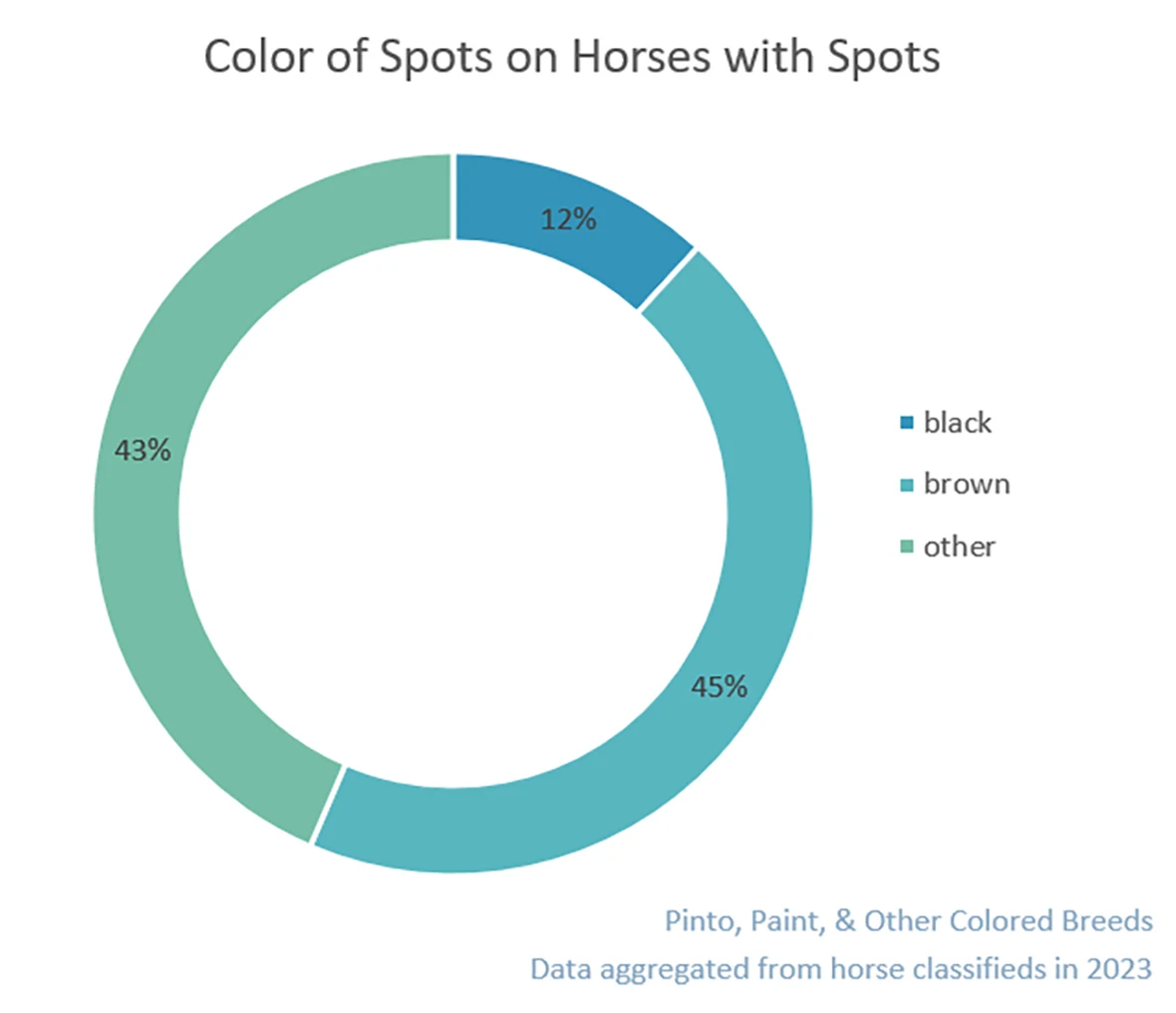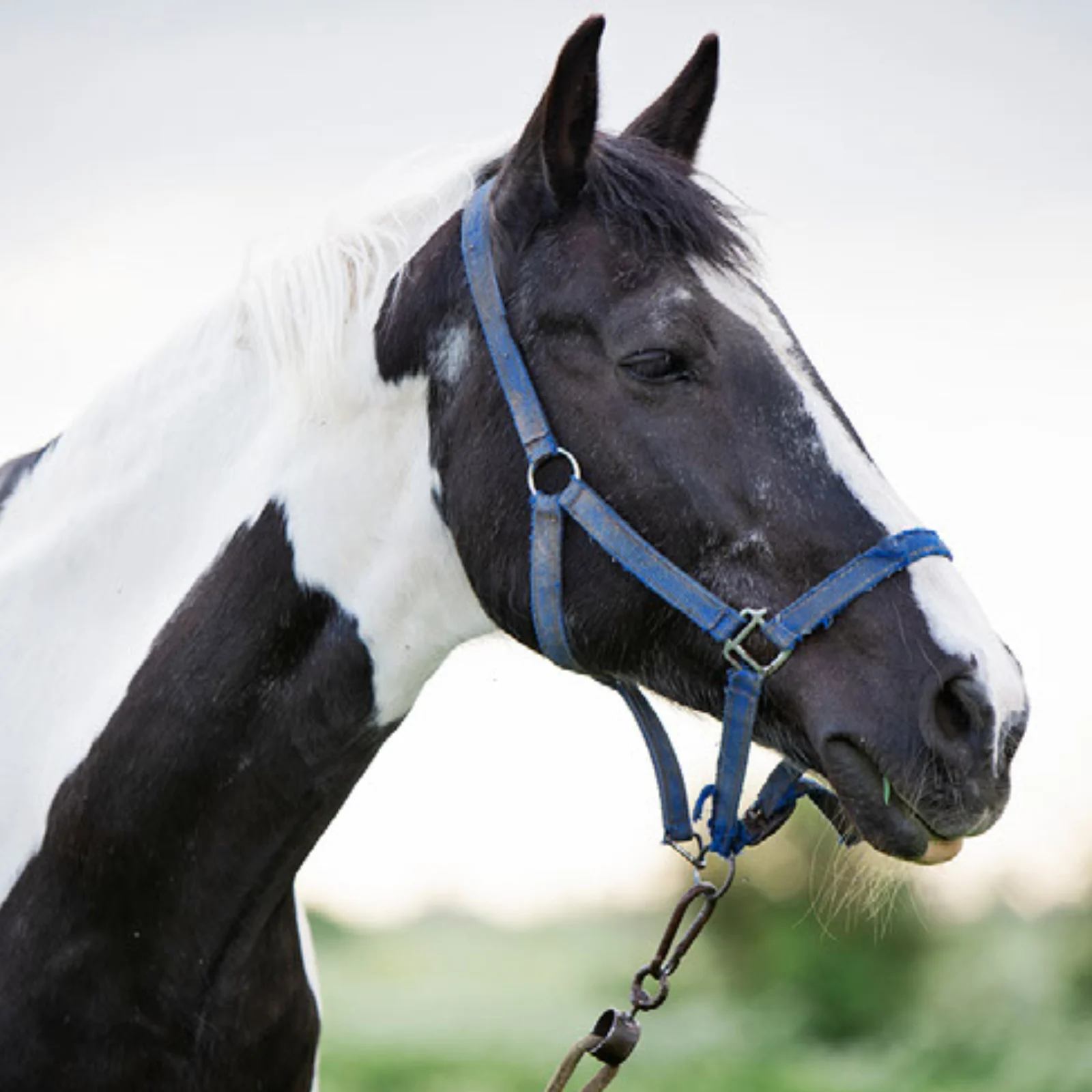A piebald horse is a white horse with large black spots. Piebald is a term most often used by older horse riders and those trained by European riding instructors.
Facts about Piebald Horses:
- Piebald Horses are somewhat rare – they make up about 2% of all horses, based on an analysis of horses for sale in summer 2023.
- The average cost of a Piebald horse is approximately $7,387.76. The average asking price of all horses for the same time period is $9,500
- This means piebald horses are 22% less expensive than the average horse. This may be because, according to one analysis, piebald horses are less desirable in certain horse sports.1
- Today in America, the term piebald has mostly fallen out of use, even by riders. In our analysis of horse classified ads in Summer 2023, NO horses were listed as piebald, though deeper data analysis revealed that over 100 piebald horses were for sale, but were typically listed as Paint or Pinto horses with a black basecoat.

Image description for screen readers: A donut chart titled “color of spots on horses with spots”. The donut chart shows that 12% of spotted horses have black spots, 45% of horses with spots have brown spots, and 43% of horses with spots have spots of another color (grey, palomino, dun, buckskin, etc). This data was aggregated from horse classified ads in 2023 using data from paint, pinto, and color breeds.
What a Piebald Horse Looks Like
Piebald horses exclusively have black and white coloration. No other colors are present in a piebald horse’s fur. Therefore, if a horse possesses any other color, it is not a piebald.
Some piebald horses have primarily white bodies with just a few black spots, while others are covered almost exclusively with black patches- leaving little room for white.
Here’s a flowchart our team made to help identify a piebald horse, and tell the difference between a piebald and a paint horse:

Image description for screen readers: A flowchart titled “IS THIS HORSE PIEBALD? A FLOWCHART” begins with “Does it have spots?”. An arrow pointing to no leads to “no, the horse is not a piebald”. An arrow pointing to yes goes to the question “What color are the spots?” An arrow pointing to no leads to “no, but the horse might be a skewbald”. An arrow pointing to yes leads to “is the horse registered as a paint horse?” An arrow pointing to yes leads to “Piebald is not recognized as a color for paint horses.” An arrow leading to yes points to no leads to “Yes! The horse is a PIEBALD!”
Other Names for Piebald Horses
As mentioned earlier, piebald horses are often referred to as pintos or paint horses.
Pinto and Paint horses are often confused with each other. Adding piebald to the mix can be dizzying!
Here’s a table summarizing the similarities and differences between paint, pinto, and piebald horses:
| Paint Horses | Pinto Horses | Piebald Horses | |
|---|---|---|---|
| Coat Patterns | Large areas of white combined with another color | Large patches of white and another color | Large patches of white and black |
| Breed | A specific breed known as the Paint Horse | Term used to describe horses with any color pinto pattern | Term used to describe horses with white and black pinto patterns |
| Specific Types | Tobiano and Overo | Various patterns and color combinations | Limited to black and white |
| Markings | White patches often cross over the back | Patches can be scattered or blended | not specified |
| Color Range | Wide range of patterns and color combinations | Wide range of patterns and color combinations | Exclusively black and white |
Rarity of Piebald Horses
Piebald horses are considered relatively rare, as their distinct coat patterns are not as common as solid-colored or evenly patterned horses. However, their scarcity varies depending on the region and breed. It’s always a treat to come across a piebald horse and admire its unique beauty! 🦄🌟
Piebald horses have long been a part of horse breeds in North America and other continents. This type of spotted horse came to North America when, “In 1519, Spanish explorer Hernán Cortés brought a spotted horse to North America”3
Piebald Horse Temperament: 🧬 Nature or Nurture? 🧬
How a horse acts isn’t just about its color- in fact, color hardly has anything to do with it! Horse behavior (like whether they bite, bolt, or buck) has a lot to do with things like their genes, how they’re handled as yearlings, how they’re trained, and how much time people spend with them when they’re baby horses. Some kinds of horses might be more jumpy than others, but it’s not because of their coat color or pattern. 🐴💖
In the UK, where piebald horses are common and affordable, they are often chosen as kids’ first horses! These steady and trustworthy white horses with black spots are trusted with young beginner riders because they’re usually calm and easy to handle. Grade horses are often geldings, which may help their temperament. 👦👧🐴

How Much Does a Piebald Horse Cost?
The cost of piebald horses can change based on the breed, where you live, and other things. They might be more or less expensive than horses without spots. 💵🐴
For example, in a place like Oklahoma, where there are a lot of black and white paint horses, a piebald horse might cost the same as a quarter horse that’s one solid color and has had the same amount of training. But if the piebald pattern is really cool – or the horse has tons of horse show ribbons won – it might cost a little bit more. 👀💲
The cost of a piebald horse can vary significantly based on factors such as:
- Age
- Breed
- Training
- Overall quality
Prices can range anywhere from a few thousand dollars to many tens of thousands of dollars. The average price for a piebald horse is $7,387.76. Remember, owning a horse is a long-term commitment, so it’s essential to consider the costs of care and maintenance when deciding to buy your first horse. 💰💕
Piebald Horse vs Skewbald Horses: Color Differences
While piebald and skewbald horses both have patches of white and another color, there is a slight difference in their coat patterns:
- Piebald Horses: Piebald horses have patches of white and black. The white patches are usually stark and well-defined against the black color, creating a bold contrast.
- Skewbald Horses: Skewbald horses, on the other hand, have patches of white and any color other than black. These patches can be any color, including, chestnut, bay, or even palomino. The distribution of colors on skewbald horses may be more blended and mottled compared to the clear contrast of piebalds.
Piebald Horse Breeds
Piebald coloring can be found in various horse breeds, but it is most commonly associated with:
- Gypsy Vanner Horses: By far the most popular breed in which piebald coloring occurs regularly, the Gypsy Vanner horse originates from the United Kingdom and Europe, where they are known as cobs (the British equivalent of a grade- or unregistered- horse). Gypsy Vanner horses are known for their beautiful piebald or (less often) skewbald coats and luxurious long fur on their lower legs.
- American Paint Horses: Paint horses, a breed developed in the United States, often exhibit piebald or skewbald patterns. However they are not called piebalds. This is a key to sounding like an experienced horseperson: within paint horse circles, the term piebald is never used to describe a horse.
- Pinto Horses: Pinto is not a specific breed but rather a term used to describe any horse with large patches of white and another color. Many pintos are white horses with brown spots. Read more about pinto horses and how to spot them.
- Fisker Hansen, A. (2016). INVESTIGATING EVALUATOR BIAS WHEN ASSESSING POTENTIAL PERFORMANCE HORSES WITH RESPECT TO HORSE COAT COLOUR. Plymouth University [↩]
- Haynes, G. W. (1988). The American Paint Horse. United Kingdom: University of Oklahoma Press. [↩]
- Denniston, D. (2005). The American Paint Horse. United States: Capstone Press. [↩]


